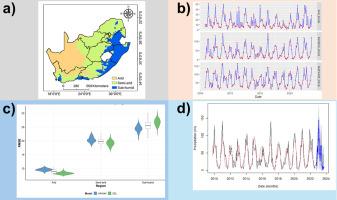Predicting precipitation using dynamic distributed lag models in arid and sub-humid regions of South Africa
IF 3.3
Q2 MULTIDISCIPLINARY SCIENCES
引用次数: 0
Abstract
Ocean characteristics have contributed to a series of unusual rainfall patterns and floods, leading to severe land degradation, loss of life and infrastructure in various regions. Modelling and prediction of precipitation using in-situ data and oceanographic variables is possible. There are limited studies to substantiate this approach in less-developed countries. This study aims to model and predict precipitation in the arid, semi-arid and sub-humid regions of South Africa using dynamic linear regression (DLR) models, with sea surface temperature (SST) anomalies, evaporation-precipitation differences, longwave radiation (lwRad), net surface heat flux and relative humidity as input variables. The prediction accuracy of the autoregressive integrated moving average model with extra data (ARIMAX) and dynamic distributed lag (DDL) models was compared on the mean monthly rainfall data for the period 2008 to 2022. The results highlighted that the DDL models predict better than the other ARIMAX models, with SST anomalies and lwRad having a significant contribution (p-values < 0.05). These models had the smallest root mean squared error (RMSE) values for the arid (8.27 mm), semi-arid (19.15 mm) and the sub-humid (26.77 mm) regions, indicating that DDL models are suitable tools for the prediction of precipitation in these regions. However, additional oceanographic predictors such as sea surface salinity, ocean heat content, and upper-ocean current patterns may further enhance precipitation prediction accuracy, particularly in regions with strong ocean-atmosphere coupling, such as coastal or monsoon-influenced areas.

利用动态分布滞后模型预测南非干旱和半湿润地区的降水
海洋的特点造成了一系列不寻常的降雨模式和洪水,导致各区域严重的土地退化、生命和基础设施的损失。利用原位数据和海洋学变量模拟和预测降水是可能的。在欠发达国家证实这一方法的研究有限。以海温(SST)异常、蒸发-降水差异、长波辐射(lwRad)、净地表热通量和相对湿度为输入变量,利用动态线性回归(DLR)模型对南非干旱、半干旱和半湿润地区的降水进行建模和预测。利用2008 ~ 2022年的月平均降水资料,比较了ARIMAX自回归综合移动平均模型和DDL动态分布滞后模型的预测精度。结果表明,DDL模型的预测效果优于其他ARIMAX模型,海温异常和lwRad的贡献显著(p值<; 0.05)。这些模式在干旱(8.27 mm)、半干旱(19.15 mm)和半湿润(26.77 mm)地区的均方根误差(RMSE)最小,表明DDL模式适合这些地区的降水预测。然而,海面盐度、海洋热含量和上层海流模式等其他海洋学预测指标可进一步提高降水预测的准确性,特别是在海洋-大气耦合强烈的地区,如沿海或受季风影响的地区。
本文章由计算机程序翻译,如有差异,请以英文原文为准。
求助全文
约1分钟内获得全文
求助全文
来源期刊

Scientific African
Multidisciplinary-Multidisciplinary
CiteScore
5.60
自引率
3.40%
发文量
332
审稿时长
10 weeks
 求助内容:
求助内容: 应助结果提醒方式:
应助结果提醒方式:


